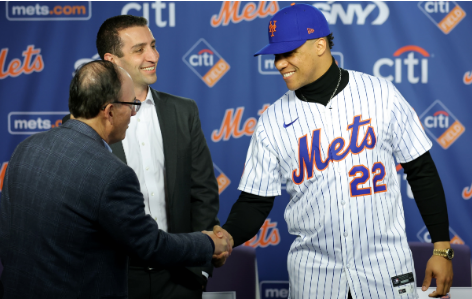
In December 2024, the baseball world was stunned as the New York Mets signed Juan Soto to a record-shattering 15-year, $765 million contract, the largest deal in professional sports history. The move was a statement of intent from the Mets, signaling their commitment to build a championship-caliber roster. However, not everyone in the baseball community is sold on the deal, including some former players who view the contract with skepticism.
One former Mets outfielder, speaking anonymously, expressed concerns about the long-term ramifications of such a massive financial commitment. While acknowledging Soto’s exceptional skill set, the former player questioned whether the contract would hamper the Mets’ ability to stay flexible in the years to come.
“I get why they did it—Soto is one of the most talented hitters in the game,” the former outfielder shared. “But handing out a deal like this means locking yourself into one player for a decade and a half. That could limit the Mets’ options in terms of building around him, especially with all the changes happening in the league. It’s a lot of money, and I wonder if they’re thinking too far ahead.”
Soto, who has established himself as one of Major League Baseball’s brightest stars, was instrumental in the Mets’ decision to make this historic investment. The slugger’s ability to consistently perform at an elite level made him an obvious choice for a long-term commitment. However, the sheer size of the contract raises important questions about financial strategy and roster construction for the Mets.
The deal is undeniably bold, but some critics, like the former Mets outfielder, believe it could have unintended consequences. By dedicating such a substantial portion of their budget to Soto, the Mets might find themselves limited in future free-agent pursuits or unable to address other roster needs as the years go on. There’s also the risk of injury or performance decline over a lengthy contract, which could leave the Mets stuck with an underperforming player at an exorbitant price tag.
While some former players like Soto’s former teammate, Yankees pitcher Gerrit Cole, see the deal as a positive for the game—pointing to the financial health of Major League Baseball and the overall growth of player salaries—others remain cautious about the long-term risks involved. “It’s good for the game when players are getting paid what they deserve,” Cole said. “But from a team-building standpoint, it’s something every front office has to seriously think about. A contract like this isn’t just about the player; it’s about balancing the entire roster for years down the road.”
On the other side of the spectrum, Mets general manager David Stearns was quick to emphasize the unique qualities Soto brings to the team. “Juan’s consistency and leadership are exactly what we need to get to the next level,” Stearns explained. “This isn’t just a financial decision—it’s a strategic one. We believe he can be a centerpiece of our team for the next 15 years.”
As the Mets’ commitment to Soto reshapes the roster’s financial structure, fans and analysts alike will be watching closely to see if the move pays off. If the team struggles to build around Soto in the coming years or if the star’s production begins to decline, the deal could be remembered as a cautionary tale in the world of sports contracts.
Ultimately, the real test will come as the 2025 season progresses. Will the Mets emerge as legitimate World Series contenders thanks to Soto’s contributions? Or will the long-term nature of the deal put too much strain on the team’s ability to adapt and grow in an ever-evolving baseball landscape?
As for the former Mets outfielder, he remains skeptical about the long-term sustainability of the deal. “I hope I’m wrong,” he said. “But $765 million is a lot of pressure to put on one player—and one organization.”

Leave a Reply